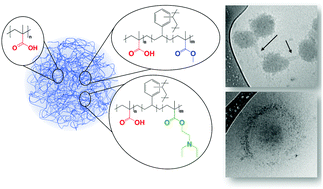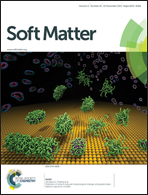Polyacid microgels with adaptive hydrophobic pockets and ampholytic character: synthesis, solution properties and insights into internal nanostructure by cryogenic-TEM†
Abstract
Microgels with internal and reconfigurable complex nanostructure are emerging as possible adaptive particles, yet they remain challenging to design synthetically. Here, we report the synthesis of highly charged poly(methacrylic acid) (PMAA) microgels incorporating permanent (poly(methyl methacrylate) (PMMA)) and switchable hydrophobic pockets (poly(N,N′-diethylaminoethyl methacrylate) (PDEAEMA)) via emulsion polymerization. We demonstrate detailed tuning of the size, crosslinking density and tailored incorporation of functional comonomers into the polyacid microgels. Analysis via cryo-TEM and pyrene probe measurements reveal switchable hydrophobic pockets inside the microgels as a function of pH. The particles show a rich diversity of internal phase-segregation, that adapts to the surrounding conditions. Large amounts of hydrophobic pockets even lead to hydrophobic bridging between particles. The study shows ways towards tailored polyelectrolyte microgels with narrow dispersity, high charge density, as well as tailored and reconfigurable hydrophobic compartments and interactions.


 Please wait while we load your content...
Please wait while we load your content...